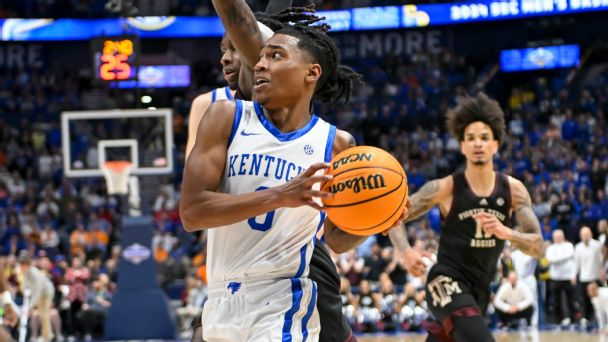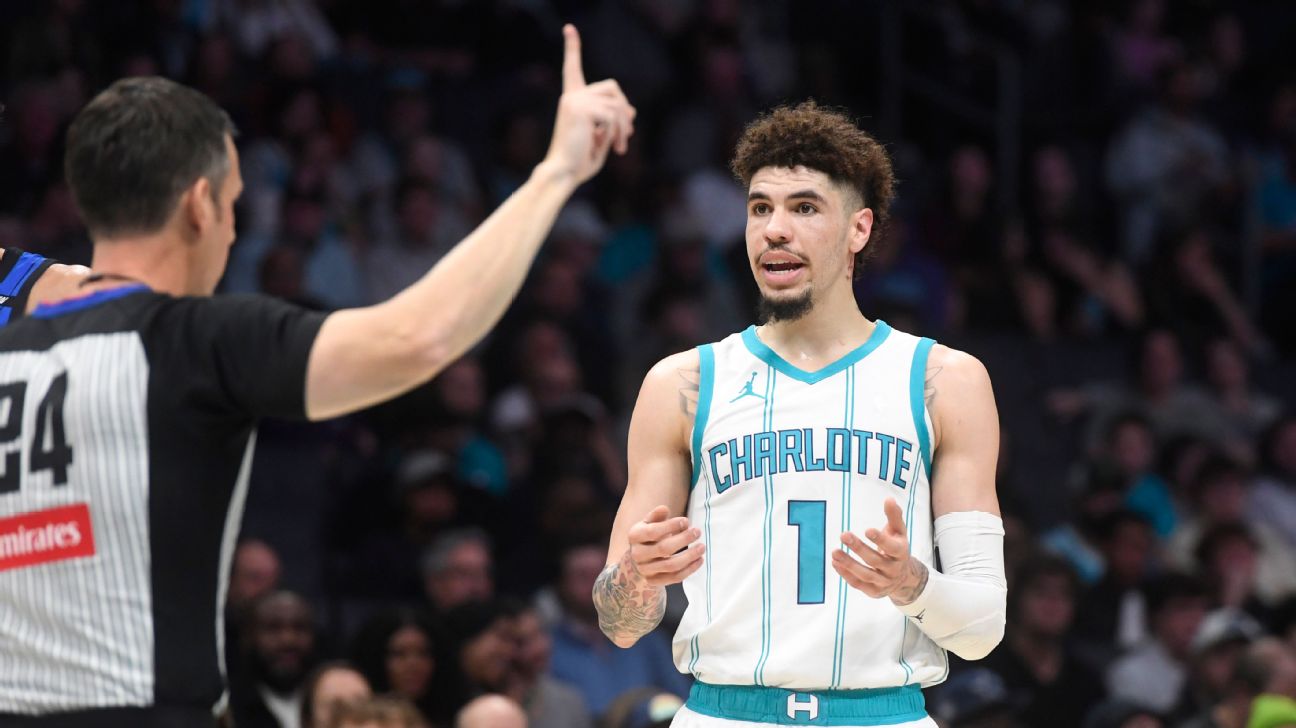Steve Roberts-USA TODAY Sports
With so much uncertainty surrounding the 2024 NBA draft class, ESPN draft analyst Jeremy Woo will take a closer look at the prospects that are in contention of being drafted No. 1 overall.
Despite coming off the bench for a talented Kentucky team, Rob Dillingham has emerged as a top prospect and, along with likely fellow lottery pick Reed Sheppard, helps give the Wildcats the deepest (and youngest) star backcourt in the country. He’s crept up our rankings all season as a result, putting himself in the mix among the biggest names in what’s continued to look like a difficult top of the draft for NBA front offices. His unique scoring ability has forced teams to consider his upside despite some significant risk built in.
Woo breaks down Dillingham’s game, looks at his strengths and weaknesses, and provides a player comp for him moving forward.
Rob Dillingham | PG/SG | Age: 19.2 | Kentucky
Dillingham’s strengths
Dillingham is tough to cover playing off the dribble, with the ability to quickly stop and pop jumpers out to the 3-point line, and also finish creatively in the paint. He’s made a significant jump as a 3-point shooter in college, improving to 44.9% from deep on 5.2 attempts per game (he shot 35.8% from 3 with Overtime Elite last year), with a number of impressive shots this season despite playing 23 minutes per game. He has an excellent handle, gets to spots effectively, finishes with both hands, and has a penchant for hitting difficult, off-balance shots.
Dillingham’s upside is tied to whether he can take all of these elements of his game and refine them to handle a full-time point guard workload. When he’s making shots from long range and has everything going, he looks like the type of player worth gambling on. He’s one of the best pure scorers in the draft, and has forced his way into the conversation early with the offensive gifts he brings to the table as the NBA continues to skew heavily toward offensive production.
Rob Dillingham sends his defender to the floor and hits the layup for Kentucky.
Dillingham’s weaknesses
There is no way around Dillingham’s lack of size, physical strength and bulk being an uphill climb for him adding value on defense in the NBA. He measured at 6-foot-1½ and 176 pounds with a 6-2 wingspan at Kentucky’s preseason combine, putting him in a similar ballpark to players including the Atlanta Hawks’ Trae Young, the Brooklyn Nets’ Dennis Smith Jr. and the Miami Heat’s Patty Mills based on the measurements in the DraftExpress database. He’s going to get exploited defensively in the NBA, and there’s not a lot Dillingham can do about it other than improve his communication, awareness and effort on that end. This will be the major concern for front offices in evaluating his case.
Dillingham’s lack of size and length may also create some complications for him as a finisher in the paint, where he’s been effective (55.8% per BartTorvik). He’s likely not going to punish people at the rim — he’s only averaging three free throw attempts per game — so placing an emphasis on attacking space, using ball screens, and developing additional craft and timing as he scores downhill is crucial. There’s also some concern that his shooting could regress, as he’s just a 79.2% career free throw shooter, per our database, which includes his EYBL and Overtime Elite seasons dating back to 2021.
The other concern is that he’s more of a scorer than playmaker. He can be sloppy with the ball at times and isn’t a highly advanced half-court passer yet, so he’ll need to master the finer elements of point guard play to compete at a high level — a taller task at his size, with fewer passes easily available to him.
My favorite Dillingham game
Crazy shot-making display from Kentucky’s Rob Dillingham vs Tennessee, dropping 35 points in 27 minutes on 6/8 shooting from beyond the arc. The projected top-10 pick is shooting 41% for 3 on the season. pic.twitter.com/DkLl7AG2bW
— Jonathan Givony (@DraftExpress) February 5, 2024
Dillingham had everything on display in his 35-point showing against Tennessee, showcasing his shiftiness off the bounce and shot-making skills from 3 with his confidence running high against one of the best teams in the country. There wasn’t much the Vols could do to slow him down, and if he can find a way to hit this level on a regular basis, he’ll be a difference-maker.
Dillingham’s NBA player comp
The absolute high end of the spectrum for Dillingham would be a Trae Young-like career arc, but Young was far more prolific as a passer in his year at Oklahoma where he was tasked with a lot more responsibility and volume. The more realistic way to view Dillingham (albeit, one that doesn’t necessarily help his case atop the draft) is through the lens of a possible microwave scorer — Lou Williams being a best-case version of that mold. Williams had some excellent prime years, but was most valuable as a bench player due to his defensive shortcomings. Dillingham similarly doesn’t project safely as a franchise point guard, but his scoring ability is likely to have some form of utility, potentially at a high level.
Projected lottery team that provides best fit for Dillingham
Any team in need of backcourt help should at least consider Dillingham’s candidacy, with the Washington Wizards and San Antonio Spurs at the top of the list. Washington is in transition, with basically nothing on the roster tied down, and while it might behoove them to take a more versatile, malleable player as a result (in line with last year’s selection of Bilal Coulibaly), Dillingham’s scoring ability could have utility there. The Spurs have the luxury of Victor Wembanyama as their defensive backbone, perhaps creating a scenario to entertain taking an offense-only player like Dillingham — although his ball-dominant style doesn’t mesh with the players San Antonio has traditionally valued. There’s no perfect fit here, but any team willing to take a leap of faith on his skillset could reap the benefits.
Rob Dillingham buries the three from the top of the key to tie the score at 87-87 for the Wildcats.
Why Dillingham could go No. 1
In a draft stacked with imperfect upside bets, there is a case for Dillingham and his creative ability as a home-run selection, hoping he develops into a player capable of shouldering heavy usage and running quality offense. Like most of the top players in this polarizing class, the actual strength of that case depends heavily on who you ask. But if you’re picking at the top of the draft and attempting to filter for long-term upside, Dillingham has a level of star power as a scorer that nobody else in this draft class has.
There’s also undeniably quite a bit of risk baked into that type of profile. If Dillingham hits a high-end outcome as a legitimate starting point guard, who can be an offensive engine, it’ll help justify what he gives up defensively — but we’ve seen, even in a best-case scenario with a star like Trae Young, there are structural challenges teams face in building out winning defensive infrastructure around small guards. It makes for a potentially tricky value proposition relative to the contract a team might have to give Dillingham if he turns into a legitimate star. And, if he’s too much of a liability to justify that type of usage, he likely slots in as an undersized bench scorer, which teams will avoid with a top pick. Those scenarios are part of the bargain a team will make with Dillingham.
Teams have to weigh the risk and reward relative to what else is on the board. With the way the 2024 draft has shaped up — with no consensus on the No. 1 prospect and no traditional candidate lying in wait — a player in Dillingham’s mold has a far more legitimate argument, if a team is willing to roll the dice.



